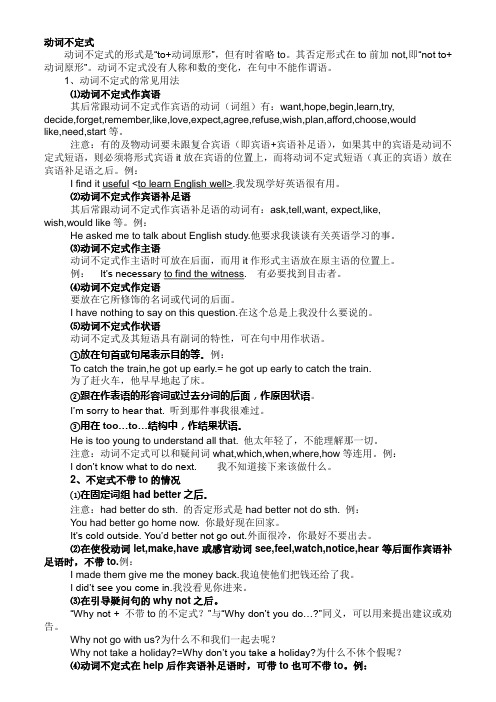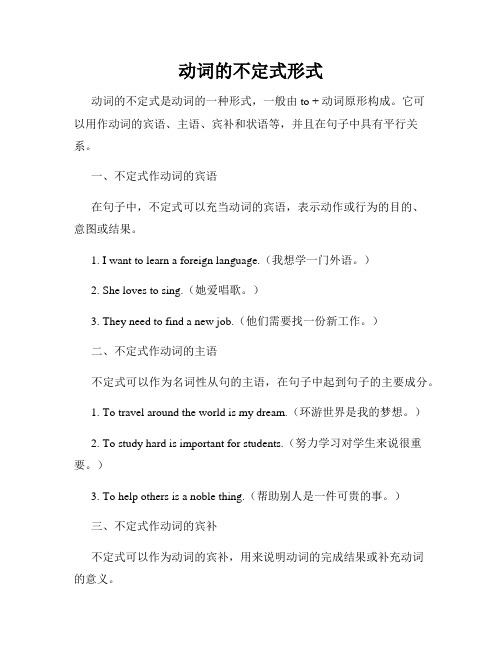动词不定式的形式
动词不定式的用法有哪些

动词不定式的用法有哪些?动词不定式在中学英语中应用非常广泛,一方面在句中可起名词、形容词或副词的作用,同时也可在句中作主语、宾语、定语、状语和宾语补足语。
动词不定式的形式是:to +动词原形,但to有时要省去。
而动词不定式在具体运用时用不用to,取决于谓语动词的用法。
现就以下几方面介绍如下:一、不定式结构1. 带to的不定式结构能直接跟带to的不定式结构的动词主要有:want, expect,plan,begin,start,ask, tell, hope, learn, try, decide, forget, remember, like, love, stop, go, come等。
如:I want to go to the movies with you. 我想跟你一起去看电影。
Don’t forget to turn off the light before you leave.在你离开之前别忘了关灯。
注意:动词不定式的否定形式是在不定式前直接加not,即not to do sth.。
如:Dave told me not to wake up Kate. 大卫告诉我别叫醒凯特。
2. 不定式有时和一连接代(副)词一起构成宾语。
如:I don’t know what to say.我不知道说什么。
3. 不带to的不定式结构以下几种情况使用不带to的动词不定式:(1)在固定词组had better之后。
注意:had better的否定形式是had better not do sth.。
如:You had better go home now. 你最好现在回家。
It’s cold outside. You’d better not go out. 外面很冷,你最好不要出去。
(2)在let, make, see, feel, watch, hear,have等感官或使役动词后,要跟不带to的动词不定式作宾语补足语。
动词不定式

动词不定式动词不定式的形式是“to+动词原形”,但有时省略to。
其否定形式在to前加not,即“not to+动词原形”。
动词不定式没有人称和数的变化,在句中不能作谓语。
1、动词不定式的常见用法⑴动词不定式作宾语其后常跟动词不定式作宾语的动词(词组)有:want,hope,begin,learn,try,decide,forget,remember,like,love,expect,agree,refuse,wish,plan,afford,choose,wouldlike,need,start等。
注意:有的及物动词要未跟复合宾语(即宾语+宾语补足语),如果其中的宾语是动词不定式短语,则必须将形式宾语it放在宾语的位置上,而将动词不定式短语(真正的宾语)放在宾语补足语之后。
例:I find it useful <to learn English well>.我发现学好英语很有用。
⑵动词不定式作宾语补足语其后常跟动词不定式作宾语补足语的动词有:ask,tell,want, expect,like,wish,would like等。
例:He asked me to talk about English study.他要求我谈谈有关英语学习的事。
⑶动词不定式作主语动词不定式作主语时可放在后面,而用it作形式主语放在原主语的位置上。
例:It’s necessary to find the witness. 有必要找到目击者。
⑷动词不定式作定语要放在它所修饰的名词或代词的后面。
I have nothing to say on this question.在这个总是上我没什么要说的。
⑸动词不定式作状语动词不定式及其短语具有副词的特性,可在句中用作状语。
①放在句首或句尾表示目的等。
例:To catch the train,he got up early.= he got up early to catch the train.为了赶火车,他早早地起了床。
常见的动词不定式

常见的动词不定式动词不定式是指动词加上不定式符号“to”所构成的动词形式,常常用来作为动词的宾语、主语、表语等。
下面列举常见的动词不定式:1. to be:表示“是”,常用于主语、表语和补语中,例如“ To be or not to be, that is the question.”(生存还是毁灭,这是个问题。
)2. to have:表示“有”,常用于宾语中,例如“ I want to havea cup of coffee.”(我想要喝一杯咖啡。
)3. to do:表示“做”,常用于宾语或主语中,例如“ I like to do yoga in the morning.”(我喜欢早上做瑜伽。
)4. to go:表示“去”,常用于宾语或主语中,例如“ I want to go to the beach this weekend.”(我想这个周末去海滩。
)5. to see:表示“看见”,常用于宾语中,例如“ I hope to see you soon.”(我希望能早日见到你。
)6. to hear:表示“听到”,常用于宾语中,例如“ I didn't hear him knocking at the door.”(我没有听到他敲门声。
)7. to learn:表示“学习”,常用于宾语中,例如“ I want to learn Spanish.”(我想学习西班牙语。
)8. to speak:表示“说话”,常用于宾语中,例如“ I need to speak with my boss.”(我需要和我的老板谈话。
)9. to read:表示“阅读”,常用于宾语中,例如“ I like to readbooks in my free time.”(我喜欢在空闲时间读书。
)10. to write:表示“写作”,常用于宾语中,例如“ I need to write a report for my boss.”(我需要为我的老板写一份报告。
动词不定式

动词不定式特征:动词不定式没有人称和数的变化,在句中不能独立作谓语。
结构:动词不定式的肯定形式是to+do;否定形式是not to+do。
1.作主语可以直接作主语。
如:To see is to believe.眼见为实。
但在英语中,常用it作形式主语,真正的主语即动词不定式放在后面。
如:It's wrong to play tricks on other people.规律:动词不定式在句中作主语时,常放在It is +adj.(形容词)+to do sth.句型中,it仅作形式主语。
真正的主语为动词不定式。
2.作宾语1)want,decide ,agree,would like等动词后面跟并且只能跟不定式。
如:We agreed/wanted/decided/would like to start early2)love,like ,begin,start,hate ,prefer等词后可加to do 或者doing。
提示板:like doing指经常性动作,而like to do指一次性的动作。
如:I like swimming,but I don't like to swim now.我喜游泳,但现在不想游。
3)stop,forget,remember,go on ,try等词或短语后面可以接不定式或者ING。
但是意思区别很大。
如:stop to do sth.:停止一件事,去做另一件事。
stop doing sth.:停止正在做的事。
Forget/remember to do sth: 忘记/记得去做某事Forget /remember doing sth:忘记、记得做过某事。
go on to do sth: 接着做另外一件事Go on doing sth: 接着做同一件事情Try to do sth:努力去做某事Try doing sth:尝试做某事3.作宾语补足语1)tell,ask,want,order,teach,invite,warn,wish,help,get,wish,help 等词后面常接不定式作宾补。
动词的不定式形式

动词的不定式形式动词的不定式是动词的一种形式,一般由to + 动词原形构成。
它可以用作动词的宾语、主语、宾补和状语等,并且在句子中具有平行关系。
一、不定式作动词的宾语在句子中,不定式可以充当动词的宾语,表示动作或行为的目的、意图或结果。
1. I want to learn a foreign language.(我想学一门外语。
)2. She loves to sing.(她爱唱歌。
)3. They need to find a new job.(他们需要找一份新工作。
)二、不定式作动词的主语不定式可以作为名词性从句的主语,在句子中起到句子的主要成分。
1. To travel around the world is my dream.(环游世界是我的梦想。
)2. To study hard is important for students.(努力学习对学生来说很重要。
)3. To help others is a noble thing.(帮助别人是一件可贵的事。
)三、不定式作动词的宾补不定式可以作为动词的宾补,用来说明动词的完成结果或补充动词的意义。
1. I made her promise not to be late again.(我使她保证不再迟到。
)2. He found the key to open the door.(他找到了打开门的钥匙。
)3. They considered it necessary to attend the meeting.(他们认为参加会议是必要的。
)四、不定式作状语不定式可以作为动词的状语,表示目的、结果、条件、方式等。
1. He exercises every day to keep fit.(他每天锻炼以保持健康。
)2. She spoke loudly to be heard by everyone.(她大声讲话,以便所有人都能听到。
)3. In order to pass the exam, he studied hard.(为了通过考试,他努力学习。
动词不定式的形式和用法

动词不定式的形式和用法动词不定式是英语中一种特殊的动词形式,它有自己的形式和用法。
本文将详细介绍动词不定式的形式和用法。
一、动词不定式的形式1. 基本形式:动词不定式的基本形式是“to + 动词原形”,比如:“to go”、“to eat”等。
动词不定式的基本形式没有时态和人称的变化。
2. 完成形式:动词不定式的完成形式是“to have + 动词过去分词”,例如:“to have gone”、“to have eaten”等。
动词不定式的完成形式表示在动词不定式动作之前已经发生或完成的动作。
3. 被动形式:动词不定式的被动形式是“to be + 动词过去分词”,例如:“to be gone”、“to be eaten”等。
动词不定式的被动形式表示动作的接受者是动作的执行者。
二、动词不定式的用法1. 作主语:动词不定式可以作为句子的主语,例如:“To learn English is important for students.”(学习英语对学生来说很重要)。
2. 作宾语:动词不定式可以作及物动词或介词的宾语,例如:“I want to go to the cinema.”(我想去电影院)。
“She is good at playing the piano.”(她擅长弹钢琴)。
3. 作表语:动词不定式可以作系动词的表语,例如:“Her dream isto become a doctor.”(她的梦想是成为一名医生)。
4. 作补语:动词不定式可以作及物动词的宾补,表示动作的目的或结果,例如:“She made a decision to study abroad.”(她决定出国留学)。
5. 作定语:动词不定式可以修饰名词,表示名词的用途、用法等,例如:“a book to read”(一本可以阅读的书)。
6. 作状语:动词不定式可以作句子的状语,表示目的、原因、结果等,例如:“I study hard to pass the exam.”(我努力学习为了通过考试)。
动词的不定式

动词不定式动词不定式在中学英语中应用非常广泛,一方面在句中可以起名词,形容词,或副词的作用,同时也可在句中做主语,宾语,表语等。
动词不定式的形式一般是“to+动词原形”,但是to 有时候可以省去。
(一)不定式做主语动词不定式做主语时,句子中谓语动词常用单数,其位置有以下两种。
1.把动词不定式置于句首。
To see is to believe .百闻不如一见2.用it 做形式主语,把真正的主语不定式放在后面,常有以下句型(1).It+be +名词+to do sth.It’s our duty to take good care of the old. 好好照顾老人是我们的责任。
(2)It takes sb +some time +to do sthHow long did it take you to finish the work? 完成这项工作你花了多少时间(3)It +be+形容词+for sb+to do sth.It’s necessary for you to lock the car.锁车是很有必要的。
(4)It +be +形容词+ of sb+to do sth.It was silly of us to believe him.我们真愚蠢,竟然相信了他的话。
(5)It seems\appears +形容词+to do sth.It seemed impossible to save money.省钱看起来是不可能的(二)动词不定式做宾语能以不定式做宾语的动词很多,常见的有:want,like,wish,hate,prefer,hope,continue,manage,try,ask,offer,start,forge t,promise,mean,pretend,intend,begin,attempt,decide,learn,desire,agree, care,choose,determine,undertake,expect等。
动词不定式

C-不定式的概念、作用语法梳理不定式一、概念:在语法中,动词不定式是指动词的一种不带词形变化从而不指示人称、数量、时态的形式。
形式为:to+动词原形+其他。
之所以被叫做不定式,是因为动词不被限定,或者说不被词形变化所局限。
不定式属于非谓语动词。
不定式的时态有:一般式、进行式、完成式和完成进行式。
二、不定式的作用1、作主语。
不定式作主语时,谓语用单数。
往往用it作形式主语,把不定式放在谓语后面。
如:It took us two hours to finish the job.It is impossible for us to get there on time.It is very kind of you to help us.注意:(1)其他系动词如look, appear等也可用于此句型。
(2)当不定式作主语的句子中又有一个不定式作表语时,不能用It is …to…的句型。
试比较:It is to negate(取消,否定)my own idea to believe him.(错)To believe him is to negate my own idea .(对)(3)It is+ adj. of / for sb. to do sth. 结构中,当不定式的逻辑主语和前面的形容词可以构成系表结构时,用of, 否则用for.2、作宾语(1)动词+不定式。
如:He managed to escape from the fire.I find it hard to get along with him.(it 作形式宾语)(2)动词+疑问词+to , “特殊疑问句+不定式”相当于名词,作宾语。
如:I don’t know what to do next/ how to do it next.I can’t decide when to go there.注意:不定式短语作宾语时,如果还带有宾语补足语,往往把不定式短语放在宾语补足语之后,用it 作形式宾语。
- 1、下载文档前请自行甄别文档内容的完整性,平台不提供额外的编辑、内容补充、找答案等附加服务。
- 2、"仅部分预览"的文档,不可在线预览部分如存在完整性等问题,可反馈申请退款(可完整预览的文档不适用该条件!)。
- 3、如文档侵犯您的权益,请联系客服反馈,我们会尽快为您处理(人工客服工作时间:9:00-18:30)。
一、动词不定式的形式1. 动词不定式各种形式有:一般式、完成式、不定式的进行式、不定式的完成进行式、不定式一般式和完成式的被动语态。
以下几种情况用不定式的主动形式表示被动意义:a. 在某些静态形容词后作状语的不定式:如 easy , hard , difficult , tiresome ,good , heavy , interesting 等。
b. 当不定式的动作与所修饰的名词是逻辑上的动宾关系时,可以用主动表示被动。
c. 在too … to 或 enough to 结构中,不定式主动表被动。
2. 不定式的否定式不定式的否定形式是在不定式前加否定词 not 或 never 等。
3. 不定式短语a. 疑问词 + 不定式在 tell , show , teach , find out , decide , discuss , learn , ask , advise ,remember , know 等动词后常用“疑问词 + 不定式”这一结构作其定语。
b. of/ for sb to do当不定式作主语时,可以有自己的逻辑主语,指明动作的执行者。
常常使用 for 来引出不定式的逻辑主语,但当和不定式搭配的形容词是表示主语的品行、性格特征和行为表现时,需要用 of 来代替 for ,引出其逻辑主语。
使用 of 的此类形容词有: kind , foolish , stupid , wise , nice , clever ,silly , rude , careless , thoughtful 等。
二、动词不定式充当各种句子成分的具体用法。
动词不定式可以充当除谓语之外的任外的任何句子成分。
1. 不定式作主语a. 动词不定式可以放在句首作句子的主语,表示某个具体或将来的动作。
例如:To swim in the river is dangerous.b. 在现代英语中为了平衡句子,人们常用先行词 it 作形式主语,而把真正的作主语不定式放在后边。
如:It is dangerous to swim in the river.c. 在上述 b 的情况下,可以用介词 for 或 of 来引出动词不定式的逻辑主语。
例如:It is difficult for the foreigners to learn Chinese.2. 不定式作宾语a. 动词不定式可以作某些动词的宾语,表示某个具体的动作或行为。
例如:I can't afford to buy a new car.这样的动词有: wish , hope , manage , ask , offer , promise , pretend ,decide 等。
b. 有些动词后既可以接动名词作宾语,也可接不定式作宾语。
但表达的意义不尽一样,动名词作宾语表示动作的经常性、习惯性,而不定式作宾语则表示某次具体的活动或行为。
这样的动词有: start , begin , continue , fear , like , love 等。
例如:I like swimming, but I don't like to swim in such cold weather. (like swimming 表示一种习惯,而 like to swim in such cold weather 则表示一种具体的动作 )c. “疑问句 + 不定式”这一结构可以充当某些动词的宾语。
d. 有时可以用 it 作形式宾语,而把真正作宾语的动词不定式放在后面。
例如:I fine it hard to persuade her.e. 有些动词后面接不定式作宾语表示动作尚未发生,接动名词作宾语表示动作已经发生。
如 remember , forget , stop , try , mean 等。
例如:I remember locking the door. ( lock 动作已经发生)Please remember to lock the door when you leave. ( lock 动作还没有发生)3. 动词不定式作表语My job is to teach you English.4. 动词不定式作宾语补足语a. 动词不定式可以用在某些动词后面作其宾语补足语。
例如:He helps me to study English.此类动词有: advise , ask , allow , expect , encourage , force , permit ,order , persuade , request , tell , want , wish 等。
b. 但不定式在下列这些词后面作宾补时,不定式符号要去掉。
如: make , let , have ,see , hear , watch , notice , observe , feel 等。
5. 动词不定式作主语补足语The boy was made to work all day long.比较: They made the boy work all day long.6. 动词不定式作定语a. 动词不定式可以用在名词后面作定语。
例如:I have many letters to answer.b. 但如果动词不定式的动词为不及物动词时,要在其后面加上适当的介词。
如:She has only a cold room to live in.c. 动词不定式作定语还可表示将来发生的动作。
例如:The meeting to be held tomorrow will be of great importance.7. 动词不定式作状语a. 表目的。
例如:He worked hard to support his large family.有时为了加强语气,不定式可以提前到句首,也可以用 in order to 或 so as to 来引导目的状语,但是 so as to 不能放在句首。
b. 表结果。
例如:He hurried home to find his wife gone.有时,可以在不定式前用 only 来加强语气。
c. 表原因。
例如:We are proud to be Chinese.三、不定式符号的省略1. 在使役动词 have, let, make 之后。
2. 在感官动词 feel, hear, see, watch, notice, observe, listen to, look at 之后。
3. 在 why 和 why not 之后。
4. 在其他结构之中。
如:a. can do nothing / everything but / except dob. cannot help / choose but doc. cannot but dod. had better do sthe. would rather do sthf. help sb (to) do sth 或 help (to) do四、不定式符号的单独使用为了避免重复,不定式符号之后的动词原形及其他补充成份可以省略,这种情况常见于非正式文体中。
如: George says he is going to leave Shanghai, but I don't think he really wants to. 原句: George says he is going to leave Shanghai, but I don't think he really wants to leave Shanghai. 如果不定式符号之后的动词原形是 be 或 have done 时,要保留 be 和 have ,而随后的其他成份仍可省略。
例如:— Aren't you the manager?— No, and I don't want to be. (I don't want to be the manager)五、动词不定式的特殊用法例句To tell the truth, the solider was captured. (不定式作独立成份)说实话,那位士兵被俘了。
动词不定式是非限定性动词的一种,不能独立充当谓语动词,在形式上不受主语的人称和数的制约,也不体现句子的时态的特征。
动词不定式一般由“to+动词原形”构成。
“to”仅为符号,无实义,个别情况下可省略。
一、作主语1.不定式直接做主语。
如:(1)To do more exercise is good for our health.(2)To learn English well is not easy.为了避免头重脚轻,常用it作形式主语放在句首,作主语的不定式常放在句末。
如上两句可改为:(1)It’s good for our health to do more exercise.(2)It’s not easy to learn English well.2.“疑问词+动词不定式”作主语。
如:(1)How to use the computer is a question.(2)Where to go has not been decided yet.二、作宾语1.带to的不定式直接作动词的宾语。
如:(1)It began to rain when I got home.(2)Jim wanted to be an inventor.2.“疑问词+动词不定式”作宾语。
疑问词可以是:what、where、when、who、whom、which、whether、how等。
如:(1)I don’t know how to get there.(2)He asked what to do next.3.不定式带补语构成复合宾语时必须借助于形式宾语it。
如:I think it possible to get on well with him.三、作宾语补足语1.动词不定式作宾语补足语,事实上宾语是动词不定式的逻辑主语。
常见的能接动词不定式作“宾补”的动词有:want、ask、wish、tell、get、teach、encourage等。
如:(1)He asked Tom’s mother to take the boy home.(2)Miss Gao tells her students to ask questions.2.不定式不带,to的动词有“一感、二听、三让、四看”,即:①feel②hear、listen to③let、have、make④see、watch、notice、observe。
